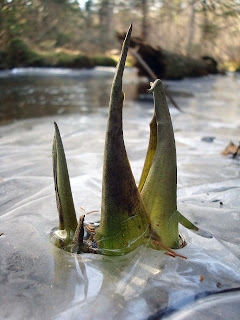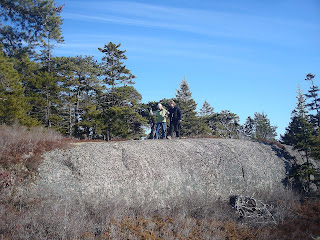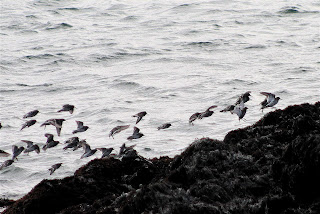Welcome to the Vinalhaven Sightings Report – February 29th , 2012
MCHT and VLT teamed up and all you get is this lousy report.
“I ******* hate skunk cabbage” - anonymous
Highlights – Raptors, Red-throated Loon, Winter Ducks, Fungus – including False Turkey Tail, Mammals and pooping, Saw-whet owl pellet, Winter Songbirds including Yellow-rumped Warbler and Pine Siskin, Great Cormorant, Cloacal kissing in the basin (hand check!). plus a new segment on Skunk Cabbage and a return of FOTM.
 Upcoming event: 2nd annual VLT sunset/woodcock/ big ol’moon walk will be Friday April 6th, 6:30-8:30pm. The plan is to take in the sunset (1), check out a big moon (2), and slap some scopage on the most user-friendly woodcock (known) on the island (3). Probably at least 2 of those things will be witnessed. 2 out of 3 ain’t bad. We’ll meet at Skoog Park to carpool and then roll out
Upcoming event: 2nd annual VLT sunset/woodcock/ big ol’moon walk will be Friday April 6th, 6:30-8:30pm. The plan is to take in the sunset (1), check out a big moon (2), and slap some scopage on the most user-friendly woodcock (known) on the island (3). Probably at least 2 of those things will be witnessed. 2 out of 3 ain’t bad. We’ll meet at Skoog Park to carpool and then roll out
 |
| i do not own an electron microscope this photo was taken with a sony cybershot. |
Seen something you think should be in the sightings report? – Then most likely it should be in here. Here’s how you can find out - go see something, and then send a report of your sighting (and photos and videos (nature stuff only please)), to sightings@myfairpoint.net. The cracker-jack and crispy VSR editing team will assess and process and will get back to you as soon as possible. It should be mentioned that Fair point (or Myfairpoint to some, depending on how patient/dumb of a person you are) currently won’t let me reply to some emails received at that address. Only the ones I want to respond to. I think there may be a connection with windy days, but I haven’t enough data on this come to any conclusion. I think there is though, .
Anyway, it’s also a good place to send comments, opinions, questions, issues and addresses of people who’d be alright with getting an email every few weeks or so when a new report is up. In the same manner, the internet giant yahoo (or in yahoo if you think of it) doesn’t always let me add folks to the email lists. we keep battlin' thru though....
 |
| no reason to lift this guy's tail to check gender all that red means its a male photo by sally conway |
Sightings – Red-bellied Woodpecker photos are in from Skin Hill. As report in the last VSR a Red-bellied Woodpecker was reported at feeders on Skin Hill. Here are a few wonderful photos of the bird! Thanks for sharing Sally, and hats off again on the great photos!
 |
| little tail fan going on. probably inspired by having to share its food with a starling photo by Sally conway |
Mockingbird - Still visiting Pat Lundholm's feeders, as reported, what 2 months ago or more! Long stretch out here for the mocker - must be good grub being offered over there.
Greens - (2/16) John Drury reports witnessing a Merlin seen flying a foot over the water, possibly flushed off Bull Rock just this side of Greens Island. White-winged Crossbills, Pine Siskins and Dark Eyed Juncos busy on Greens. More recently he watched a Northern Goshawk. John also reported a Northern Harrier flying over east main street sometime recently.
 |
| its been fun ice times, complete with melting and refreezing |
Ferry Rides - Bob out there on the boat reports a few trips with pretty big numbers of birds - (2/21) or the day of a big singular bird revolution. 77 guillemots! I think they had the bay scheduled for themselves that day because the only other birds in sight that day were 2 juvie eagles (before leaving the Narrows). (2/23) 30 kittiwakes. On that same day were 5 eagles and 4 loons before socializing put the "k-bosh" on observing. people. thanks bob!
Round Pond (2/18) – adult Red-tailed Hawk circled over the hills to the west of the pond and eventually crossed the road going northish. VVNM for palmer, red-tails are observed yearly, but are rather uncommon even with plenty of them being on the main land… (2/26) 4 Hooded Merganser – 2 male and 2 female floating close to the road in the recently melted portion of the pond.
 |
| we love perry creek |
Perry Creek - Fox Rocks – (2/18) – White-winged Crossbill, Pine Siskin, Golden-crowned Kinglet, Mink and Otter Scat….
 |
| Mink scat at Perry Creek tends to have more fish scales than other Mink scat around the island |
Noteworthy – The Mink of Perry Creek have a diet that has been (and continues to be) a fine mix of fish and vole as evidenced in their scat. Very seldom do I find fish scales in mink scat anywhere else on the island, and i can't think of another spot on the island off hand. Majority tends to be all vole, while also finding plenty of crab exoskeleton scats….Fox Rocks - (2/20) – American Robins, Sharp-shinned Hawk, White-winged Crossbill, Pine Siskin, Juncos, Golden-crowned Kinglet, Bufflehead, Eider, Common Goldeneye, Red-breasted Merganser, Otter scat…Perry Creek – (2/26) Common Raven, Crossbills,Skunk Cabbage
 |
| not much remains- inside |
 |
| huber pellet |
Owl pellet and sign - I know, I write about this all the time, but man the owl scene out here is so thick – and that’s a good thing I think. Anyway, Basin (2/24) Stevie and I found this saw-whet owl pellet on the “old harbor pond trail”. Notice the yellow rodent teeth poking out of the pellet. I took it apart on the basin walk (2/25) and it was all fur and skull.
 |
| not so lucky bunny foot....and leg....and blood |
Huber (2/27) – on a walk with Adam and Sawyer, we came across this extremely flattened owl pellet just beyond the big pine just past the first rock wall crossing. Landing in the middle of one of the more popular trails on the island – flatness was its destiny. Looks like vole remains to me and from the size of the pellet most likely Great Horned Owl, but hard to tell at this point…and then further on we found this Snowshoe Hare leg in the middle of the trail. Not flattened and appearing very fresh, there was no sign of any other part of the bunny – like it dropped from the skies. Which is most likely did! A somewhat common sight wherever Great Horneds and Snowshoe Hare “co-exist” our local Great Horned Owls love a bunny treat, but discard the Snowshoe Hare legs in a “even a great horned wouldn’t eat those” kind of fashion. I have told the story of the small pile of snowshoe hare legs under the Perry creek great horned nest a few years back.
 |
| run off is easy, when there is no freezy |
Long time friend and friend of the VSR, Mike Windsor, came out for a few nights (and days) over the long weekend and we took advantage of the beautiful weather for some nice outings - State Beach (2/19) – 2 Horned Grebe, 2 Red-necked Grebe, 8 Common Goldeneye, 5 Great Cormorants, Black Scoter, Razorbill, Bald Eagle, Old-tails, Red-breasted Merganser, Black Guillemot. The stories here (other than leify removing ice from tidepools so he could put urchin tests in the water) were the 2 Horned Grebe (don’t see many out here), Black Guillemot going thru the molt and looking pretty mottled along the process. And tops was the young Bald Eagle who spent a ton of energy flying, hovering and continually stooping on over to hassle a pair of adult Common Eider Eastern Penobscot Bay. He was out over the water for at least 10 minutes, and with a series of dives inspired the Eiders to dive and dive again. The eagle never seemed to come close to getting them (at least from our angle), but it must have seen something it liked that we couldn’t see from shore, cuz it put forth and impressive effort – especially for a slacker like and eagle. Slacker is a compliment in jersey.
Basin – (2/19) – Red-throated Loon, 6 Surf Scoter, lots of Common Loon, Bufflehead, Red-breasted Merganser (paired up with one hot couple cloacal kissing), Oldtails, Black Guillemot, Common Goldeneye…story here was the second Red-throated Loon I’ve seen in the basin (everytime Mike has gone to the basin he’s seen one) and the Black Guillemot in the Basin. Not all that common of an occurrence. Also – pair of Mergansers doing the cloacal! Circling and riding and kissing for only the briefests of brief moments. Sweet times in the Basin.
How’s the Skunk Cabbage coming? –thank you, Javier Penelosa, for, in a sense, being the inspiration for this new segment (fortunately the sense we are talking about isn’t smell). The question seems oddly put, but if you must know, the Skunk Cabbage is coming along fine. Visitors to Vinalhaven often remark about how “thick” the skunk cabbage is out here, and then they are often asked to never return- call our skunk cabbage thick will you!. Truthfully though, we have loads of ‘em (skunk cabbage that is), and they have some cool habits, so maybe it’s not an odd, or as odd as it seems, question. Let’s go back to John “who the hell is john Eastman” Eastman to find out the scoop on the cabbage, or where they have been, and should be at (ending a sentence with a preposition. Eat it Grizz!!!!)…
 |
| this is where we're at these days.... skunk cabbage wise perry creek |
 |
| spathes on ice perry creek |
“…It’s rolled up, spirelike spathe often pokes up through February snow (when there is snow – VSR editor note). The plant is actually well advanced by then, emerging cone-shaped buds of next year’s growth often begin to show in early fall. It is usually in flower by March or April, its bulging spathe enclosing the big knoblike spadix like a monk’s cowl. The spathe gaps open on one side, allowing entry to insects. Lavender, flesh-colored (who’s flesh exactly? – the purple people?- vsr editor’s note) flowers on the surface of the spadix are bisexual and pollinated by some of the earliest flying insects of the year.
 |
| skunky cold huber cabbage |
In late winter, as the flower buds enlarge, they increase in temperature, often melting snow around them (when there is snow – VSR editor note). When the surrounding ground and air warm to the above freezing, respiration of the spadix produces constant warmth of about 72 degrees, which the surrounding, air-pocketed spathe helps maintain. The tiny flowers on the spadix have no petals. They are protogynous (that is, the female parts mature first), they begin to bloom at the spadix top and progress downward. By the time the lowermost flowers emerge, the upper ones have produced their male parts and are beginning to pollinate. Male flowering likewise descends on the spadix.” – Eastman, Johnny, book of swamp and bog, page 168
Alright, Eastman jumps around as much as I do, (and I’m not even from Kalamazoo), but he packs a lot of information here. So what we find about the wetlands and sides of roads these days are the “spirelike spathes” which often can be found with the snow melted around them (once again when there is snow). My question is - does the whole melting snow thing make skunk cabbage a warm blooded plant? Damn that’s so hot if that’s what it’s considered.
 |
| huber frozen cabbge |
The skunk cabbage in the photos (2/26 – Perry Creek and 2/27 Huber) have been caught after an overnight refreeze after a few days of melting, with small stretches of rain mixed in. I think they look cool with the ice running up that one.
 |
| there are no skunk cabbage plants in this picture |
We’ll keep tabs on these funky plants as the year progresses (I’m sure you can’t wait), and give fun stories about edibility and toxicity – next update will be called – “the thin line between edible and toxic!”. For now let’s go back to Eastman for the final thought in this 1st segment of “How’s the Skunk Cabbage coming?”
“The same species occurs in Japan and other locales in eastern Asia, it’s probably origin. Paleobotanists believe that the plant migrated to North America via the Pleistocene land bridge (everyone’s favorite land bridge – VSR editor note) that existed several times between Siberia and Alaska. This makes skunk-cabbage – like humans – a relative newcomer to our continent” –Eastman, Johnny – “book of swamp and bog” , page 169. Special bond.
Note – spell check on Paleobotantists came up with the suggestion “Pale botanists”. Flesh-colored? Love it. And it is clearly "our" continent, whomever "our" is referring to.
 |
| false |
Fungus of the month! (FOTM) – it gives all of us great pleasure in announcing not only the return of the fungus of the month bit, but that the FOTM for February 2012 is False Turkey Tail (Stereum ostrea) congratulations! False Turkey Tails are an uncommon sight on Vinalhaven, at times I can go a few years in a row without finding one, but it appears that the mild winter we’re having has inspired some Falsies into fruiting in the Basin (2/25) and along the Huber trail (2/27). Here are some FOTM hot stats on the False Turkey Tails courtesy of Audubon Book of Mushrooms, page 497 –
Scientific Name – Stereum osterea, Stereum hirsutum,a number of other versions
Family – Steraceae (Parchment Fungus Family). Order - Aphyllophorales
Cap – 3/8 – 2 ¾ “ wide, fan shaped or semicircular, densely hairy, multicolored, with narrow smooth, shiny, russet to brownish transverse zones.
Fertile surface- smooth; buff to cinnamon buff (we all know the difference)
Season – June-January
Habitat – On logs and stumps of deciduous wood.
Range – throughout North America
 |
| true |
So what’s this all mean? False Turkey Tails are decomposers, they are the biggest of the Stereum, and seem to grow on Vinalhaven out of “season”. They are in the Parchment family (a parchment in a pear tree!), which means their fertile surface (underside) is satiny smooth (or at least smooth) as opposed to true Turkey Tails (Trametes versicolor) which are polypores (many pores) whose fertile surface is dotted with holes or pores. This is the easiest way to tell the two species apart.
But in reality its more confusing than that. That is both true and false Turkey Tails are conglomerates of several closely related species that can only be told apart microscopically, if then. There is so much more to learn about fungus, kind of gets you excited about them, right? In a completely platonic way of course.
 |
| slapping some glass on some crossbills |
and then there was leify-
enjoying the winter to say the least and fox rocks especially!-
there's been some great conitions for flying kites -
so go fly one and we'll see you out there.































